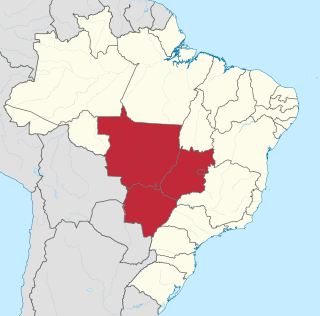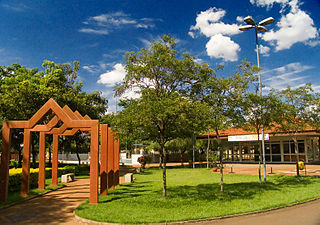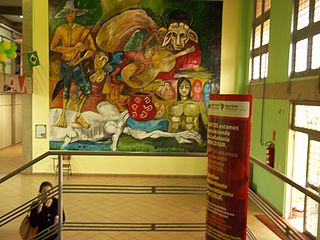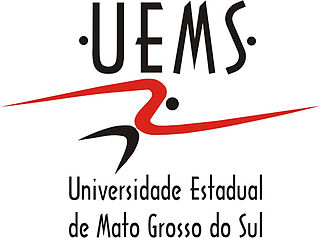
Mato Grosso do Sul is one of Brazil's 27 federal units, located in the southern part of the Central-West Region, bordering five Brazilian states: Mato Grosso, Goiás and Minas Gerais (northeast), São Paulo (east) and Paraná (southeast); and two South American countries: Paraguay and Bolivia (west). It is divided into 79 municipalities and covers an area of 357,145.532 square kilometers, which is about the same size as Germany. With a population of 2,839,188 inhabitants in 2021, Mato Grosso do Sul is the 21st most populous state in Brazil.

Campo Grande is a city in the central and western region of Brazil, capital of the state of Mato Grosso do Sul. Historically a stronghold of separatists from the North and South, founded by José Antônio Pereira. The city is planned in the middle of a vast green space, with wide streets and tree-lined avenues with several gardens along the way. It is one of the most wooded cities in Brazil, with 96.3% of houses in shade.

The Central-West or Center-West Region of Brazil is composed of the states of Goiás, Mato Grosso and Mato Grosso do Sul; along with Distrito Federal, where Brazil's national capital, Brasília, is situated. The region comprises 18.86% of the national territory, and is the least populated in Brazil.

Corumbá is a municipality in the Brazilian state of Mato Grosso do Sul, 425 km northwest of Campo Grande, the state's capital. It has a population of approximately 112,000 inhabitants, and its economy is based mainly on agriculture, animal husbandry, mineral extraction, and tourism, being the gateway to the biggest wetlands of the world, the Pantanal. Due to its border with Bolivia, Bolivians in Brazil constitute a significant portion of the city's population, forming a distinct cultural community. The city is served by Corumbá International Airport.

Morenão, also known as Estádio Universitário Pedro Pedrossian, is the home ground of Operário and Esporte Clube Comercial. It is located at Cidade Universitária, in Campo Grande, Mato Grosso do Sul, Brazil.

The Federal University of Mato Grosso is a public university in the state of Mato Grosso, Brazil. Responsible for serving the entire state, its main campus is in the capital city of Cuiabá. Smaller campuses are located in Barra do Garças, Pontal do Araguaia, Sinop, and Várzea Grande, while the former campus at Rondonópolis is now the Federal University of Rondonópolis, split off in 2018.

Dourados is a Brazilian municipality, situated in the state of Mato Grosso do Sul, 225 km (140 mi) Southwest of Campo Grande. It has a population of about 225,000 inhabitants, and its economy is based mainly in arable agriculture and in cattle ranching. Dourados is also the second most populous and important city of this state.

The Western Military Command is one of the eight Military Commands of the Brazilian Army. The Western Military Command is responsible for the defense of the states Mato Grosso and Mato Grosso do Sul.

The Dom Bosco Catholic University is a private, non-profit Catholic university, located in Campo Grande, the capital of the State of Mato Grosso do Sul, in western Brazil. It is maintained by the Catholic Archdiocese of Campo Grande.

José Manuel Fontanillas Fragelli was a Brazilian politician, lawyer and academic. Fragelli served as the governor of Mato Grosso from 1970 until 1974 and the President of the Senate of Brazil from 1985 through 1987.

The Federal University of Grande Dourados is a Brazilian public institution which is located in the city of Dourados, state of Mato Grosso do Sul, Brazil.

The Mato Grosso do Sul State University is a public university in the state of Mato Grosso do Sul, Brazil. It has 15 campuses all over the state, and its rectory is located in the city of Dourados.

Federal Institute of Education, Science and Technology is a Brazilian institution of higher education with a number of campi around Brazil. Comprising Brazil's Federal Network of Vocational, Scientific and Technological Education, it offers students a wide range of curricula, including both general education and specialized vocational and professional training in science, technology, and pedagogy.

The 2022 Mato Grosso do Sul state election took place in the state of Mato Grosso do Sul, Brazil between 2 October 2022 and 30 October 2022. Voters elected a governor, vice governor, a senator, 8 representatives for the Chamber of Deputies of Brazil and 24 Legislative Assembly members. The incumbent governor at the time, Reinaldo Azambuja, wasn't allowed to run for reelection for a third consecutive time due to term limits established by the Federal Constitution of Brazil.

Miss Mato Grosso do Sul is a Brazilian Beauty pageant which selects the representative for the State of Mato Grosso do Sul at the Miss Brazil contest. The pageant was created in 1979 and has been held every year since with the exception of 1990-1991, 1993, and 2020. The pageant is held annually with representation of several municipalities. Since 2023, the State director of Miss Mato Grosso do Sul is, Frank Rossatte.
A mayoral election in Campo Grande was held on 6 October 2024. Voters will elect a mayor, vice-mayor and 29 councilors for a four-year term.
The Brazilian state of Mato Grosso was the focus of tenentist military conspiracies and the stage of a series of revolts in the 1920s: by the command of the Military Circumscription of Mato Grosso (CMMT), in Campo Grande in 1922, by the 10th Regiment of Independent Cavalry of Bela Vista in 1924, and the 17th Battalion of Caçadores of Corumbá in 1925. Tenentist forces from other states also made incursions into Mato Grosso: the remnants from the São Paulo Revolt, in 1924, and the Prestes Column in 1925 and again in 1926–1927. A state of emergency was in force in the Mato Grosso from August 1924 until the end of 1925, and again from October 1926 to February 1927.
Gleice Jane Barbosa, commonly known as Gleice Jane, is a Brazilian teacher, politician, and social activist. She is a member of the Workers' Party (PT) and currently serves as a state deputy in the Legislative Assembly of Mato Grosso do Sul (ALEMS).















